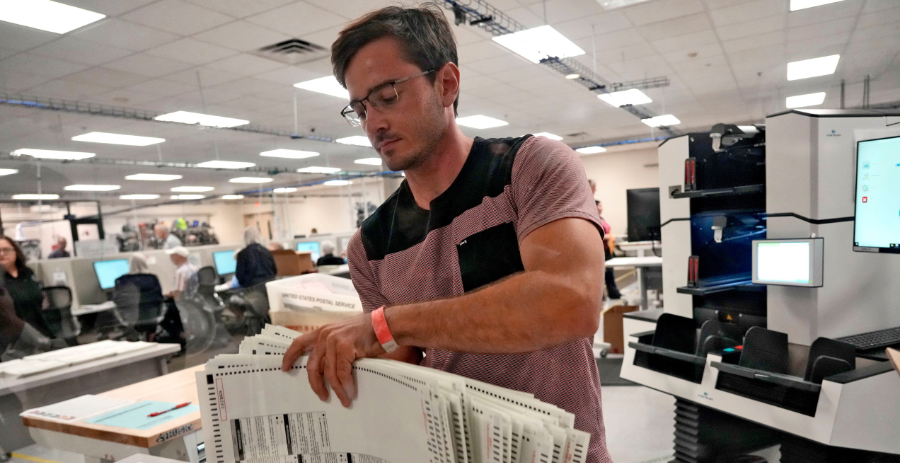It was fought in the Supreme Court this weekend as a legal dispute over whether voters were being denied the right to fix their signatures on ballots.
Lost in the legal debate, however, was that the shorter time of two fewer days – upheld by the state’s high court – actually is just a small part of a much larger measure approved by state lawmakers earlier this year designed to tighten up the election schedule. That’s because members of both parties, each believing their presidential candidate would win, wanted to ensure that all the vote tallying and legal fights were done in time so that Arizona’s 11 electoral votes would count.
But what’s really at the heart of the law, including the change in the deadline for Arizonans to ”cure” their ballots – the deadline unsuccessfully fought by the American Civil Liberties Union and the League of United Latin American Citizens – is an effort by Congress to avoid a repeat of what happened four years ago when there was a bid to have Trump declared the winner despite the actual vote.
And that affected more than just that cure period.
Legislation approved in February and signed by Democratic Gov. Katie Hobbs also:
– advanced the date of the state primary to late July;
– shortened the time counties have before they must canvass the vote;
– moved up the deadline for the statewide canvass;
– allowed recounts to start before that full statewide canvass.
And all those changes were made to ensure Arizona would have a say in this year’s presidential race.
It started when Congress in 2022 amended the Electoral Count Act. That 1887 law set up the procedures under which Congress would tally the electoral votes from each state to determine who was elected.
But weaknesses in that law came under scrutiny after the 2020 election when competing slates of electors claimed they were the rightful picks, regardless of each state’s popular vote. That happened here when Republicans submitted their own slate of ”fake” electors for Trump in a scheme to claim the state’s 11 electoral votes despite the fact Joe Biden won the popular vote here.
Those electors and allies who helped launch the plan have since been indicted on state charges of forgery and conspiracy. Those who have not yet made deals with prosecutors are set to go on trial next year.
What Congress did is clarify the federal law to spell out it is the governor – and only the governor – who sends the slate of electors. It also provides for expedited judicial.
And gone is a provision that allowed a single senator and a single representative to object to a state’s electoral votes. Now it takes at least one fifth of the U.S. House and Senate to raise objections.
Perhaps most significantly, the 2020 law also clarifies that the vice president’s role in the process is only administrative, without the power to resolve disputes over electors. That was in direct response to Trump trying to get his vice president, Mike Pence, to disregard the 2020 electoral tally.
All that had fallout for Arizona.
That federal law now provides a hard-and-fast deadline for states to get the formal results to Congress to have them considered.
This year it falls on Dec. 11.
The federal law also eliminates a provision that used to give states a bit more time to conduct their post-election activities, like recounts. Now, there is no margin for error: Votes not finalized and transmitted by Dec. 11 simply might not be counted when the Electoral College is scheduled to meet six days later.
All that is not a problem for Arizona if there are no disputes.
But a 2022 state law now requires an automatic recount if the margin of difference between the candidates is at least 0.5%, up from 0.1%. And given the results of the 2020 presidential race where Biden defeated Trump by just 10,457 votes – about 0.3% – lawmakers feared there could be a repeat situation this year.
That, however, ran into another provision of prior Arizona law which said a recount could not begin until after the statewide canvass. And that must follow each county’s canvass – a calendar that election officials said could extend beyond Dec. 11.
Counties, which used to have until the end of the month, now must complete their formal canvass by Nov. 21. And the official statewide canvass is four days later.
And to tighten things up further, the law also allows a judge to order a recount once counties have completed their canvass. Prior to this year, that couldn’t happen until after the statewide canvass.
Losing two days from the time that people had to cure their ballots – the fight that played out this weekend at the Arizona Supreme Court – also was part of the same state law approved in February by wide bipartisan margins as lawmakers cobbled together a few days here and there to tighten up the whole election schedule.
There also was more in that law, including moving up the primary to the end of July. With an increased chance of recounts, they wanted to be sure they had a final decision after the primary in time to prepare, send and receive the general election ballots from overseas voters.
And another provision gives officials from each party less time to ”proof” the ballots before they are printed.
(Except for the headline, this story has not been edited by PostX News and is published from a syndicated feed.)

